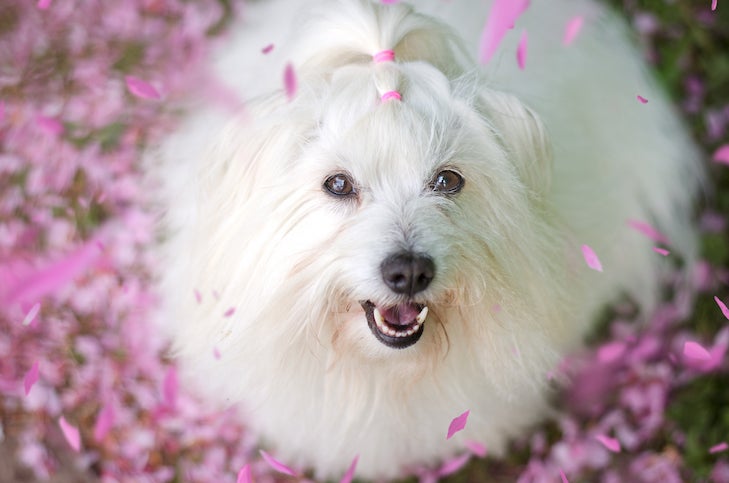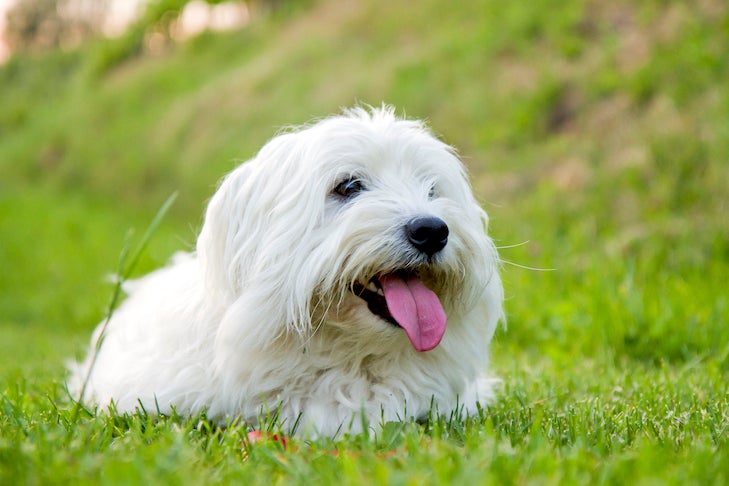AKC is a participant in affiliate advertising programs designed to provide a means for sites to earn advertising fees by advertising and linking to akc.org. If you purchase a product through this article, we may receive a portion of the sale.
It’s hard to consider a dog “white” when they have brownish-reddish tears staining their face. Yet, this is a common phenomenon in many dog breeds, particularly flat-faced dogs and those in the Bichon family. The good news is that, for many dogs, this is a common occurrence that can be addressed with wipes, dietary changes, and ensuring they have clean drinking water. There comes a time, however, when tearing necessitates a trip to the veterinarian.
Here, you can learn about preventing and cleaning tear stains on your dog’s face, along with when it’s time to consult a veterinary professional.
Why Do Some Dogs Get Tear Stains?
There are many reasons why a dog may have tear stains, both due to their breed or the environment around them.
Eye Shape
Breeds such as Pekingese and Shih Tzu, have shallow eye sockets because of their flat faces. Other similar breeds may have skin folds around the eyes that trap debris and cause irritation.
Allergies
Dogs can experience seasonal allergies that lead to watery eyes, or they could be sensitive to something in their diet, such as a particular dog food ingredient. These can be dietary or environmental allergies.

Blocked Tear Ducts
This could happen because of debris getting into the eye or a dog’s tear ducts not draining properly, leading to buildup. If cleaning the area around the eyes doesn’t work, a veterinarian can flush the duct using a saline solution.
Health Issues
Infections can cause yellow or bloody fluid to pool around a dog’s snout. This is usually accompanied by swollen or irritated eyes. A veterinarian may prescribe antibiotics to address the issue.
If your normally white-faced dog develops aggressive staining seemingly out of the blue, contact your veterinarian. They can rule out any underlying health conditions that require urgent veterinary care. They might perform a physical examination and find that the tearing has an anatomical reason, and the stains are nothing more than cosmetic.
A Dog’s Diet Can Contribute to Tearing
When dog owners picture allergens, they think of the usual suspects: dust, pollen, and dirt. However, if your dog chronically has rust-colored tearing, the culprit might not lie in the air they breathe. Instead, the food they eat may be responsible. It may surprise you to learn that some ingredients in dog food, while overall safe for consumption, can cause excessive tearing, along with other symptoms, such as red feet.
Some common food-related allergens in dogs include:
- Chicken
- Beef
- Dairy products
- Eggs
- Soy
- Lamb
- Wheat
Any breed can experience food allergies, but they’re more commonly seen in Golden Retrievers, German Shepherds, and Cocker Spaniels, among others. A veterinarian can run an allergy panel on your dog to identify the source of their allergies. Ultimately, this could stop tear stains on your dog’s face.

You can also experiment with different dog food brands, monitoring which ones result in excessive tearing. This transition can admittedly take time, as it’s advised to slowly introduce your dog to a new food to avoid gastrointestinal symptoms, such as diarrhea. Still, it could prove instrumental in putting those unsightly, brownish-red tears to an end.
What Dog Breeds Are Susceptible to Tear Staining?
It’s a common misconception that only white dogs can develop tear stains. In fact, many dog breeds are susceptible to tear staining, but their dark fur masks any discoloration. Some breeds that commonly experience this condition include:
- Bulldogs
- Boxers
- Pekingese
- Pugs
- Bullmastiffs
- Samoyeds
- Maltese
- Shih Tzu
- Boston Terriers
- Bichon Frises
- Standard Poodles, Miniature Poodles, and Toy Poodles
Mixed-breed dogs can also experience tear stains, depending on their inherited physical traits, sensitivity to environmental factors, and diet.
Preventing Tear Stains on Your Dog
After confirming that your dog isn’t experiencing any underlying health issues that cause tearing, these tips can keep your pet looking their best.

Ensure Quality Dog Food
There are so many different types of dog food, so it can be hard to figure out which one is best for your dog. Kibble versus raw is another debate – if you’re not sure, consult your veterinarian. This can also help rule out any allergies, which can result in excess tearing and other health concerns.
Examine Your Dog’s Drinking Water
Some dogs are sensitive to the additives and natural minerals in tap water. Use purified, distilled, or reverse-osmosis water sources to prevent excessive tearing.
Regularly Clean Your Dog’s Face and Eyes
A quick daily “face grooming” will go a long way in keeping those stains at bay. Some tips:
- Flush your dogs’ eyes with an appropriate canine eye wash, such as saline eye-wash solutions.
- Use an eye wash wipe and rub underneath and around the eye area. A do-it-yourself option is to mix one tablespoon of boric acid powder boiled in one cup of distilled water. Be sure to keep the solution refrigerated and remake a fresh batch weekly.
- Wash the muzzle hair with dry or waterless shampoo and a wet washcloth. You may also try diluting 3% hydrogen peroxide on a paper towel. For the best results, don’t forget to comb and blow-dry afterward.
If your dog regularly goes to the groomer, you can ask them for recommendations, too.
Keep Those Moist or “Rusty” Areas Dry
Your dog’s water bowl may cause excess water to soak their mouth and nose. Consider getting a water bowl with a narrow flare, like the ones used for birds. Alternatively, use paper towels to absorb the excess water around your dog’s mouth after they drink. You can also dust cornstarch underneath the eye, around the muzzle, and in between toes to soak up excess moisture.
Experiment With Some Food Additives
Adding one teaspoon of either organic apple-cider vinegar or buttermilk powder to meals can also prevent tearing. Your veterinarian may also prescribe mild antibiotics that can be used for short periods, such as Lincocin, Tylosin, or neomycin-polymyxin, or chloramphenicol eye drops. Vetericyn ophthalmic gel is available over the counter and may reduce tearing without a trip to the vet.

Cleaning Tear Stains on Your Dog’s Face
Your dog’s safety and comfort are paramount when it comes to cleaning tear stains. Avoid getting any solution into their eyes, and rely on verbal praise, treats, and other forms of positive reinforcement to make the process as stress-free as possible.
Here are some tips for removing those pesky stains around your dog’s eyes:
- Mix a tablespoon of mild hydrogen peroxide into an eight-ounce glass of water. Then, dip a cotton ball into the solution, being sure to wipe away from the eyes.
- Rely on specially formulated dog wipes. You can apply these every morning to your dog’s eyes, nose, and mouth.
- Trim the hair around your dog’s eyes. Excess fur around the eyes can hold onto gunk buildup and crust. If you feel uncomfortable trimming your dog’s eye hair, arrange to see a groomer. They have scissors with blades that cut away from the body.
There isn’t just one foolproof preventative for avoiding and cleaning tear stains on your dog’s face. After all, each dog responds a little differently, so it often takes a little experimenting and patience—but it’s worth the effort to have that precious face smiling at you again!
This article is intended solely as general guidance, and does not constitute health or other professional advice. Individual situations and applicable laws vary by jurisdiction, and you are encouraged to obtain appropriate advice from qualified professionals in the applicable jurisdictions. We make no representations or warranties concerning any course of action taken by any person following or otherwise using the information offered or provided in this article, including any such information associated with and provided in connection with third-party products, and we will not be liable for any direct, indirect, consequential, special, exemplary or other damages that may result, including but not limited to economic loss, injury, illness or death.

